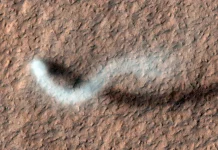
Scientists have discovered that a large mountain on the edge of Mars’ Jezero Crater is likely a volcano—a finding that could transform what we know about the Red Planet’s history and its potential for supporting life.
This unexpected discovery was made by a research team at Georgia Tech and published in Communications Earth & Environment in May 2025.
The mountain, called Jezero Mons, sits near the landing site of NASA’s Perseverance Rover.
Although the area is one of the most studied spots on Mars, no one had confirmed the volcanic nature of this mountain until now.
What’s more, this volcano could be a key piece in understanding Mars’ age, volcanic activity, and even its habitability.
The research was led by Sara C. Cuevas-Quiñones, who worked on the project as an undergraduate during a summer research program. She was supported by Professor James Wray and other colleagues at Georgia Tech and Arizona State University.
Wray had first noticed the mountain back in 2007 as a graduate student. It looked like a volcano to him, but there weren’t enough high-quality images at the time to be sure.
For years, attention stayed focused on Jezero Crater’s ancient lakebed, which was chosen as the landing site for the Perseverance Rover in 2020 because of its water-rich history and the potential for preserving signs of ancient life.
After Perseverance landed, however, one of its early discoveries was surprising—many of the rocks it encountered were volcanic, not sedimentary as expected. That led Wray and Cuevas-Quiñones to revisit the mountain and test the idea that it might be the source.
To do this, the team used data from several Mars orbiters and the rover itself.
They compared the mountain’s characteristics to known volcanoes on both Mars and Earth. While we can’t confirm its volcanic nature without visiting, the evidence strongly suggests that Jezero Mons shares the same features as real volcanoes.
This finding is exciting for many reasons. A nearby volcano could have provided heat to the area, possibly creating hydrothermal environments—conditions that may have been favorable for life. The presence of both volcanic and sedimentary rocks in the same place also makes Jezero Crater even more valuable scientifically.
Perhaps most importantly, volcanic rocks can be precisely dated using radioisotope methods. If the samples Perseverance is collecting are returned to Earth, scientists could determine exactly when Mars experienced volcanic activity, offering a clearer timeline for the planet’s history.
In short, a volcano hiding in plain sight may be the key to unlocking Mars’ secrets—and possibly, whether life ever had a chance to exist there.
Source: Georgia Institute of Technology.



